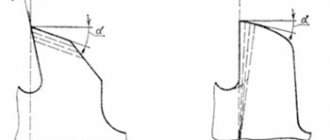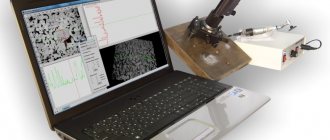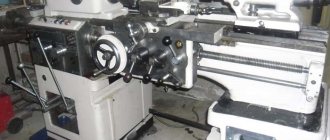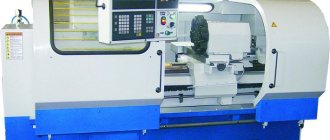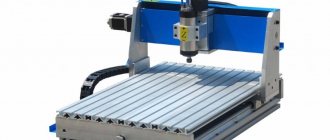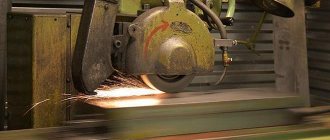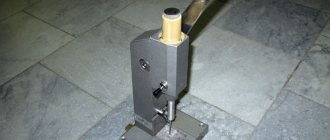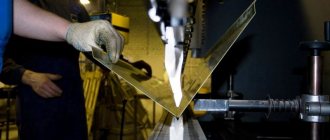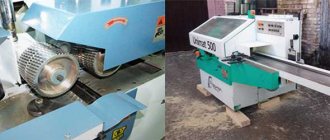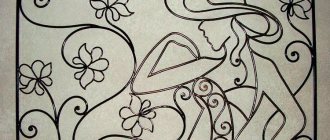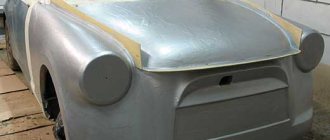Sharpening tool
For abrasive sharpening of the cutter, a sharpening machine or lathe can be used. For carbide tools, green carborundum of medium hardness is used. For initial processing, the abrasive value of the wheel should be 36-46, at the end of the process - 60-80. For high quality sharpening, a whole circle is required, without defects and geometry violations.
Diamond wheels are also widely used for sharpening turning tools, which ensures high cleanliness of cutting surfaces. In comparison with carborundum wheels, the surface cleanliness of the cutter increases by two classes, and work productivity increases. The use of diamond wheels also increases the service life of the tool - the possible number of cutter regrinds increases by 20-30%. But it should be taken into account that it is economically feasible to use sharpening with a diamond tool with an allowance of no more than 0.2 mm. For larger values, preliminary sharpening with a carborundum wheel is recommended.
Read also: How to make a tops shredder with your own hands
Features of the machines
A device used for sharpening wood turning tools and other tools, having a sharpening stone, is called a sharpening machine. Often it has a vertical arrangement of the stone, when the axis of rotation runs in a horizontal plane.
There are a huge number of options for such equipment. The most popular ones include:
- Machine with two sharpening stones. Allows you to install two different abrasives to speed up the processing process. When performing the work in question, some reinstall the abrasive used, one of which has larger abrasive chips, the other smaller ones. In order to avoid the need for constant reinstallation, such machines have two output shafts on which a circle can be mounted.
- A machine that has a bath for cooling the abrasive surface. This design feature avoids burning the metal during processing. Due to strong friction, the surface begins to heat up; when heated, the metal can change its performance. This is why you need to avoid burning the metal by using a cooling bath of water.
When choosing, you should pay attention to the power indicator, the ability to adjust performance indicators, the maximum diameter of the stone, the presence of a protective casing and other indicators.
Order and features
Depending on the nature of wear and the design of the equipment, sharpening is carried out on the front, back or both surfaces. The figure below shows all the surfaces of a turning tool
For standard cutters, as a rule, sharpening is used on all cutting surfaces. With minor wear, only the geometry of the rear surface is restored. Equipment for multi-cutting machines is restored only on the back surface, shaped – only on the front.
Standard sharpening order:
- Main back surface.
- Auxiliary back surface.
- Front surface.
- End radius.
The back surface sharpening parameters are shown in the figure below.
Figure (a) shows the back surface with one sharpening plane, figure (b) shows several. When brazing carbide inserts, the rear surface has three planes:
- along a chamfer with a height of not less than 1.5 mm at an angle a;
- along the remaining height at an angle a+3°;
- along the holder at an angle a+5°.
Sharpening the front surface of carbide cutters has many more varieties (see figure below).
Basic forms:
- Flat with a positive rake angle (a).
- Flat with a negative angle (b).
- Curvilinear with a negative angle (c).
- Flat with negative angle for roughing (d).
- Curved with a negative angle for stainless steels (d), and other materials (e)
During the sharpening process, it is necessary that the cutting edge of the tool being processed is located on the line of the center of the sharpening machine or below by no more than 3-5 mm. The direction of rotation of the circle should ensure that the plate is pressed against the holder, i.e., it should go towards the plate. During operation, a continuous supply of coolant is desirable. With periodic cooling, overstressing of the material structure and the appearance of microcracks is possible.
When sharpening, light pressure and constant movement along the surface of the wheel are required to form a smooth surface. After sharpening is completed, the geometry of the tool is checked using templates or special instruments.
How to properly use knife sharpening machines and set up a workplace
In order to properly restore the edge of a blade, you need to know how to sharpen knives on a sharpening machine and follow some rules:
- The first and main condition is to observe and maintain the correct sharpening angle throughout the entire period of work. To do this, before starting sharpening, you should securely position the base of the knife in relation to the surface of the sharpening stone and make sure that the position does not change.
- Perform only smooth movements. It is not recommended to sharpen the tool with sharp jerky movements; all actions should be smooth and sliding, otherwise microscopic defects are likely to appear on the tip, which will negatively affect the further use of the knife.
- Study the features of using bars. Some types of sharpening stones should be moistened with soapy water or oil, which is necessary to improve the glide of the blade during the sharpening process. Additional lubrication also helps remove the paste that forms as a result of the mixing of microparticles of stone and steel.
For better gliding of the knife during sharpening, the sharpening stone should be moistened with soapy water.
Helpful advice! After using the machine to sharpen scissors, knives or other tools, the abrasive must be wiped to remove all unnecessary particles. Before use, you should also wipe the sharpened blades, because small particles of ground metal remain on them.
Knife sharpening experts do not recommend trying to start sharpening yourself with expensive knives; it is better to first practice on a spare device. They also advise using an inexpensive blade before the main work. Firstly, this way you can check the sharpening tool without fear of ruining an expensive knife, and secondly, this simple manipulation will help you gain some experience.
Before using a flat knife sharpener or any other type of device, you need to prepare an optimal work area that complies with safety regulations. For example, when doing manual sharpening using a stone block, you need to firmly fasten a wooden board to the table.
It is not recommended to sharpen the knife with sudden movements; all actions should be smooth
Each user installs the block based on personal preferences: it can be located horizontally or perpendicular to the position of the master. While working, you should not try to press the base of the knife as hard as possible; movements should be progressive or jerky. If you perform all the steps carefully, the result will be a sharp blade that does not have any chips, cracks or burrs, and the entire sharpening cycle will not take more than 5-7 minutes.
Tool finishing
After sharpening, sequential grinding of the working surfaces is necessary in the same order as sharpening was carried out. When finishing, it is necessary to remove all roughness and polish the surface to a mirror shine. The cleaner the surface, the lower the friction during turning and the higher the tool life.
Finishing is carried out using boron carbide abrasive pastes on a rotating cast iron disk (no more than 2 m/s). GOI paste or other special polishing materials can be used. For polishing, paste is applied to the disc. Further, when the disk rotates, the cutter is pressed and the grains of the abrasive paste smooth out the existing roughness. Thus, the geometry and original cleanliness of the working surface of the cutter are completely restored, and its suitability for further use is ensured.
Read also: Steel for combat knives
Technological operations carried out on a lathe with workpieces using special devices are associated with ultimately obtaining a product of the desired configuration shown in the drawing. And in order for turning to be rational and accurate, sharpening of metal turning tools is necessary, which will produce the required profile, angles of the required size and the corresponding parameters of the working part. The preparation of such a tool is given great importance.
What can you use?
Sharpening can be done using two methods:
- Manual means the absence of mechanization of the entire process, that is, everything is done manually from start to finish. This method is less productive and it is quite difficult to achieve the desired result.
- There is also a device that makes sharpening chisels and wood cutters easier. Such machines also have a special stone that removes metal.
The above two processing methods are used in production. The manual method allows you to quickly sharpen the tool in case of little wear of the cutting edge and in the absence of mechanical damage. A special device allows you to restore the cutting surface and remove various defects.
Purpose of the cutter, design, types
To obtain parts from a metal ingot when turning on lathe equipment, a special tool is used. They are made of steel, and the hardness of the material is higher than that of the workpiece being processed. The holder rod and the working head, the main structural elements of a metal cutter, are used to secure the tool on the lathe.
The function of the second component is to cut off a layer of the metal surface during processing. The holder rod or the body of the cutter has a square or rectangular cross-section. The main cutting edge of the working head is shaped (wedge) or straight in cross-section. Metal cutting parts require regular sharpening during operation. In modern conditions there is a sufficient choice of incisors.
Turning tools for metal processing with replaceable inserts
When choosing gear, you should take into account such an indicator as angles. The classification of species is as follows:
- checkpoints;
- cutting;
- pruning;
- boring;
- shaped;
- grooved:
- chamfered;
- persistent;
Pass-through, this type of device processes cylindrical blanks. A cutting tool is used for cutting rods. Trimming is performed at a given angle. A cutting-type device is also used to cut grooves for various purposes in them. Scoring, this type of device is used for trimming blanks and reducing ledges. Boring, this tool is used to machine holes of the required diameter in workpieces or parts on a lathe.
Grooving - the purpose of such a device is to form internal and external grooves on a cylindrical surface, maintaining the required angles. Sometimes a cutting-type function is required when it is necessary to remove part of the metal from the workpiece. Thread-cutting machines use this device to cut threads on lathes. Shaped - the purpose of this cutter is to form protrusions and grooves on the blank being processed, thereby obtaining angles with the required parameters.
Read also: Smoke generator design for cold smoking drawings
Chamfering - with this device, after sharpening, internal and external chamfers are made on the product. The persistent one is used for turning metal parts with small ledges. To reduce vibration when working on a lathe, you need to check its position. Thrust is used for non-rigid parts.
Types of cutters are also divided according to the direction of processing of turning equipment into left and right, according to the material from which they are made, according to the method of attaching the cutting part to the holder and other parameters.
